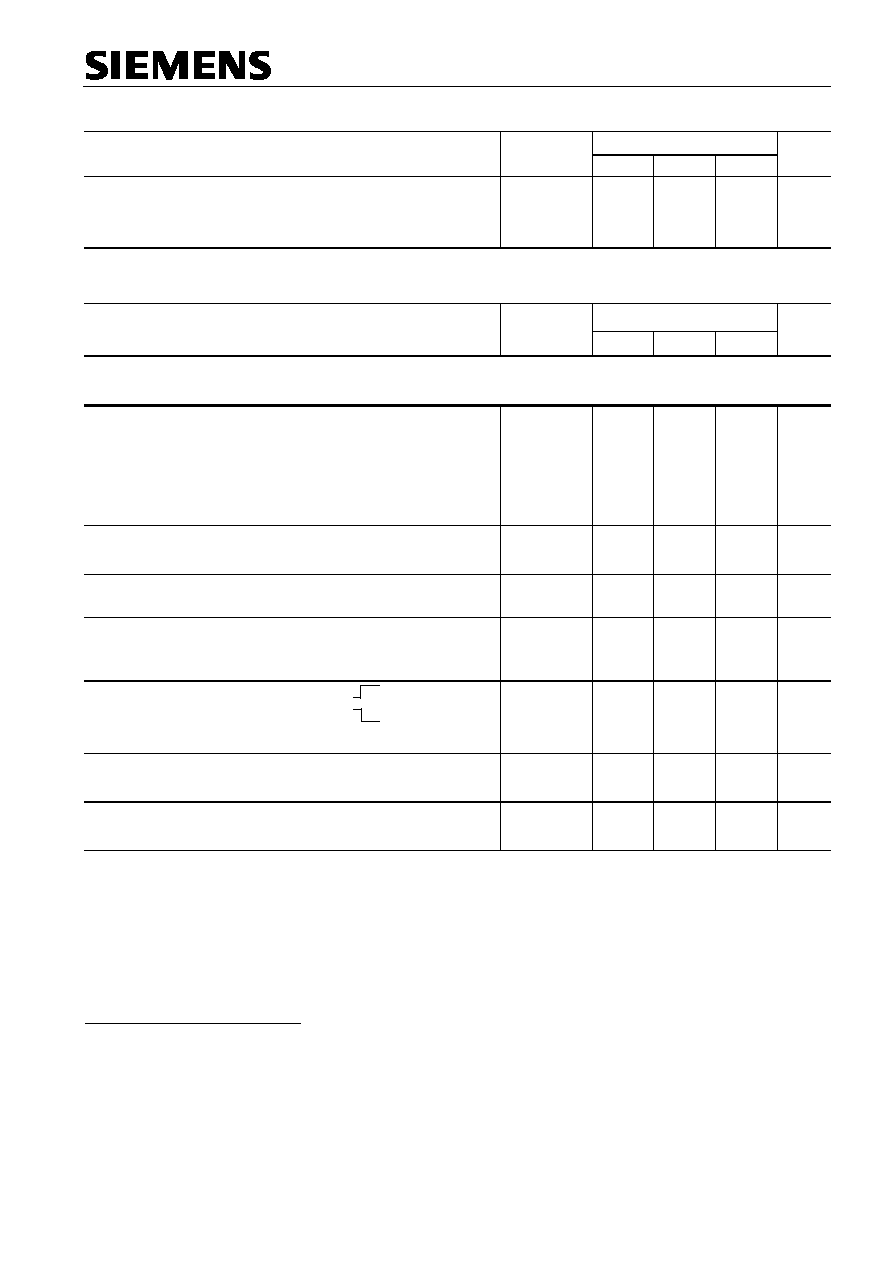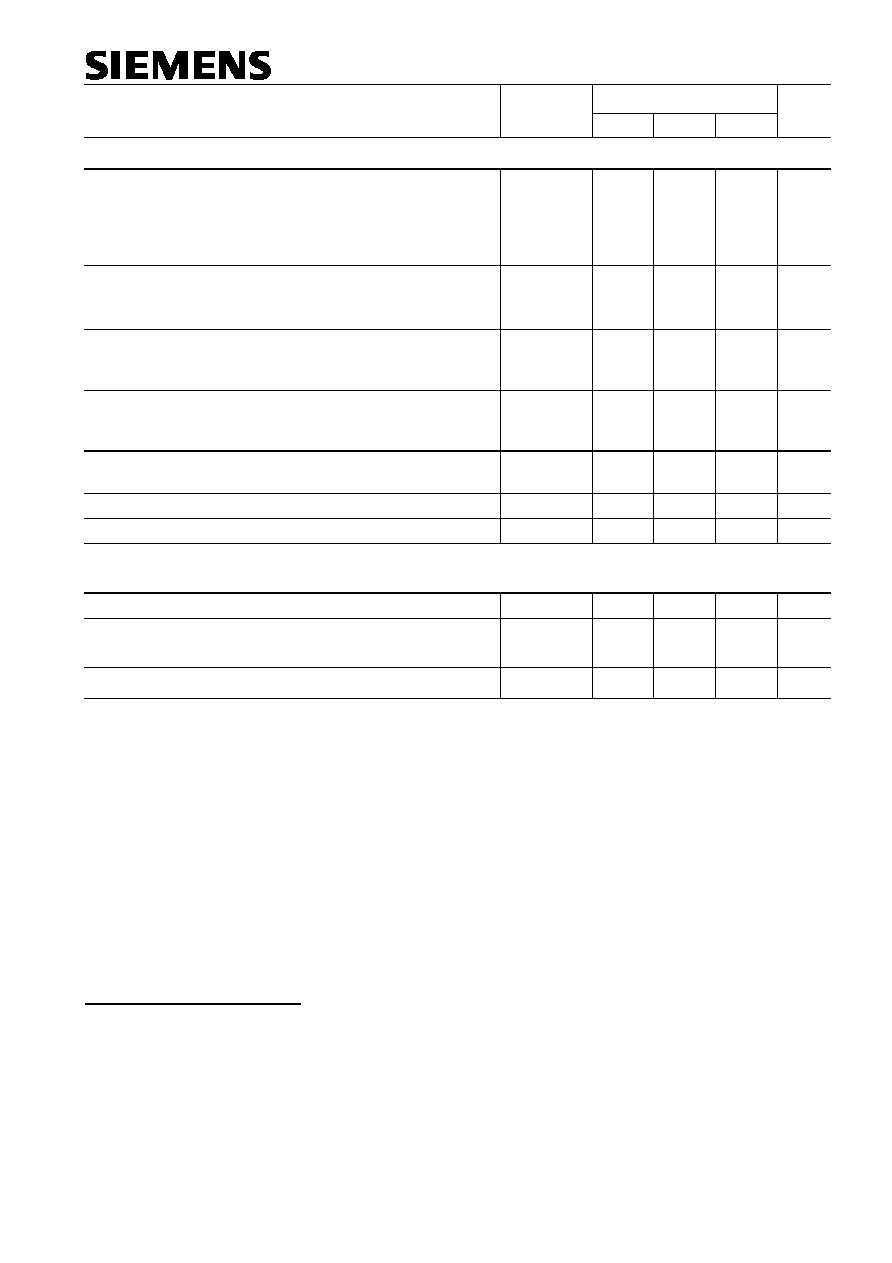
PROFET® BTS650P
Semiconductor Group Page 1 of 16
1998-Nov.-2
Smart Highside High Current Power Switch
Features
·
Overload protection
·
Current limitation
·
Short circuit protection
·
Overtemperature protection
·
Overvoltage protection (including load dump)
·
Clamp of negative voltage at output
·
Fast deenergizing of inductive loads
1
)
·
Low ohmic inverse current operation
·
Reverse battery protection
·
Diagnostic feedback with load current sense
·
Open load detection via current sense
·
Loss of
V
bb
protection
2
)
·
Electrostatic discharge (ESD) protection
Application
·
Power switch with current sense diagnostic
feedback for 12
V and 24
V DC grounded loads
·
Most suitable for loads with high inrush current
like lamps and motors; all types of resistive and
inductive loads
·
Replaces electromechanical relays, fuses and
discrete circuits
General Description
N channel vertical power FET with charge pump, current controlled input and diagnostic feedback with load
current sense, integrated in Smart SIPMOS
®
chip on chip technology. Fully protected by embedded protection
functions.
IN
Charge pump
Level shifter
Rectifier
Limit for
unclamped
ind. loads
Gate
protection
Current
limit
3
Overvoltage
protection
+ Vbb
PROFET
®
OUT
4 & Tab
1,2,6,7
Load GND
Load
Output
Voltage
detection
R
IS
IS
5
I
IS
I
L
V
IS
I
IN
Logic GND
Voltage
sensor
Voltage
source
Current
Sense
Logic
ESD
Temperature
sensor
R
bb
V
IN
1
)
With additional external diode.
2
)
Additional external diode required for energized inductive loads (see page 9).
Product Summary
Overvoltage protection
V
bb(AZ)
62
V
Output clamp
V
ON(CL)
42
V
Operating voltage
V
bb(on)
5.0
...
34
V
On-state resistance
R
ON
6.0
m
Load current (ISO)
I
L(ISO)
70
A
Short circuit current limitation
I
L(SC)
130
A
Current sense ratio
I
L :
I
IS
14 000
TO-220AB/7
1
7
Standard
1
7
SMD

BTS650P
Semiconductor Group
Page 2
1998-Nov.-2
Pin
Symbol
Function
1
OUT
O
Output to the load. The pins
1,2,6 and 7 must be shorted with each other
especially in high current applications!
3
)
2
OUT
O
Output to the load. The pins
1,2,6 and 7 must be shorted with each other
especially in high current applications!
3)
3
IN
I
Input, activates the power switch in case of short to ground
4
Vbb
+
Positive power supply voltage, the tab is electrically connected to this pin.
In high current applications the tab should be used for the V
bb
connection
instead of this pin
4
)
.
5
IS
S
Diagnostic feedback providing a sense current proportional to the load
current; zero current on failure (see Truth Table on page 7)
6
OUT
O
Output to the load. The pins
1,2,6 and 7 must be shorted with each other
especially in high current applications!
3)
7
OUT
O
Output to the load. The pins
1,2,6 and 7 must be shorted with each other
especially in high current applications!
3)
Maximum Ratings at
T
j
= 25 °C unless otherwise specified
Parameter
Symbol
Values
Unit
Supply voltage
(overvoltage protection see page 4)
V
bb
42
V
Supply voltage for short circuit protection,
T
j,start
=-40 ...+150°C:
(see diagram on page 10)
V
bb
34
V
Load current (short circuit current, see page 5)
I
L
self-limited
A
Load dump protection
V
LoadDump
=
V
A
+
V
s
,
V
A
=
13.5
V
R
I
5
)
=
2
,
R
L
=
0.54
,
t
d
=
200
ms,
IN,
IS
= open or grounded
V
Load dump
6
)
75
V
Operating temperature range
Storage temperature range
T
j
T
stg
-40 ...+150
-55 ...+150
°C
Power dissipation (DC), T
C
25 °C
P
tot
170
W
Inductive load switch-off energy dissipation, single pulse
V
bb
=
12V,
T
j,start
=
150°C,
T
C
=
150°C const.,
I
L
=
20
A, Z
L
=
7.5
mH, 0
,
see diagrams on page 10
E
AS
1.5
J
Electrostatic discharge capability (ESD)
Human Body Model acc. MIL-STD883D, method 3015.7 and ESD
assn. std. S5.1-1993, C = 100 pF, R = 1.5 k
V
ESD
4
kV
Current through input pin (DC)
Current through current sense status pin (DC)
see internal circuit diagrams on page 7 and 8
I
IN
I
IS
+15
, -250
+15
, -250
mA
3
)
Not shorting all outputs will considerably increase the on-state resistance, reduce the peak current
capability and decrease the current sense accuracy
4
)
Otherwise add up to 0.7 m
(depending on used length of the pin) to the R
ON
if the pin is used instead of
the tab.
5
)
R
I
= internal resistance of the load dump test pulse generator.
6
)
V
Load dump
is setup without the DUT connected to the generator per ISO 7637-1 and DIN 40839.

BTS650P
Semiconductor Group
Page 3
1998-Nov.-2
Thermal Characteristics
Parameter and Conditions
Symbol
Values
Unit
min
typ
max
Thermal resistance
chip - case
:
R
thJC
7
)
--
--
0.75
K/W
junction - ambient (free air):
R
thJA
--
60
--
SMD version, device on PCB
8
)
:
33
Electrical Characteristics
Parameter and Conditions
Symbol
Values
Unit
at
T
j
=
-40 ... +150
°C,
V
bb
=
12
V unless otherwise specified
min
typ
max
Load Switching Capabilities and Characteristics
On-state resistance
(Tab to pins 1,2,6,7, see
measurement circuit page 7)
I
L
=
20
A,
T
j
=
25
°C:
V
IN
=
0,
I
L
=
20
A
,
T
j
=
150
°C:
R
ON
--
4.4
7.9
6.0
10.5
m
I
L
=
90
A
,
T
j
=
150
°C:
--
10.7
V
bb
=
6V
9
)
,
I
L
=
20
A
,
T
j
=
150
°C:
R
ON(Static)
--
10
17
Nominal load current
10
)
(Tab to pins 1,2,6,7)
ISO 10483-1/6.7:
V
ON
=
0.5
V,
Tc =
85
°C
11
)
I
L(ISO)
55
70
--
A
Nominal load current
10)
, device on PCB
8))
T
A
= 85 °C,
T
j
150 °C
V
ON
0.5 V,
I
L(NOM)
13.6
17
--
A
Maximum load current in resistive range
(Tab to pins 1,2,6,7)
V
ON
=
1.8
V,
Tc =
25
°C:
see diagram on page 13
V
ON
=
1.8
V,
Tc =
150
°C:
I
L(Max)
250
150
--
--
--
--
A
Turn-on time
12
)
IIN
to 90%
V
OUT
:
Turn-off time
IIN
to 10%
V
OUT
:
R
L
=
1
,
T
j
=-40...+150°C
t
on
t
off
100
30
--
--
420
110
µ
s
Slew rate on
12)
(10 to 30%
V
OUT
)
R
L
=
1
,
T
J
= 25 °C
d
V/dt
on
--
0.7
--
V/
µ
s
Slew rate off
12)
(70 to 40%
V
OUT
)
R
L
=
1
,
T
J
= 25 °C
-d
V/dt
off
--
1.1
--
V/
µ
s
7
)
Thermal resistance R
thCH
case to heatsink (about 0.5 ... 0.9 K/W with silicone paste) not included!
8
)
Device on 50mm*50mm*1.5mm epoxy PCB FR4 with 6cm
2
(one layer, 70
µ
m thick) copper area for Vbb
connection. PCB is vertical without blown air.
9
)
Decrease of V
bb
below 10 V causes slowly a dynamic increase of R
ON
to a higher value of R
ON(Static)
. As
long as V
bIN
> V
bIN(u) max
, R
ON
increase is less than 10 % per second for T
J
< 85 °C.
10
)
Not tested, specified by design.
11
)
T
J
is about 105°C under these conditions.
12
)
See timing diagram on page 14.

BTS650P
Semiconductor Group
Page 4
1998-Nov.-2
Inverse Load Current Operation
On-state resistance
(Pins 1,2,6,7 to pin 4)
V
bIN
=
12 V,
I
L
=
-
20
A
T
j
=
25
°C:
see diagram on page 10
T
j
=
150
°C:
R
ON(inv)
--
4.4
7.9
6.0
10.5
m
Nominal inverse load current
(Pins 1,2,6,7 to Tab)
V
ON
=
-0.5
V,
Tc =
85
°C
11
I
L(inv)
55
70
--
A
Drain-source diode voltage
(V
out
> V
bb
)
I
L
=
-
20
A, I
IN
= 0, T
j
=
+150°C
-
V
ON
--
0.6
--
V
Operating Parameters
Operating voltage (
V
IN
=
0)
9,
13
)
V
bb(on)
5.0
--
34
V
Undervoltage shutdown
14
)
V
bIN(u)
1.5
3.0
4.5
V
Undervoltage start of charge pump
see diagram page
15
V
bIN(ucp)
3.0
4.5
6.0
V
Overvoltage protection
15
)
T
j
=-40°C:
I
bb
=
15
mA
T
j
=
25...+150°C:
V
bIN(Z)
60
62
--
66
--
--
V
Standby current
T
j
=-40...+25°C:
I
IN
=
0
T
j
=
150°C:
I
bb(off)
--
--
15
25
25
50
µ
A
13
)
If the device is turned on before a V
bb
-decrease, the operating voltage range is extended down to
V
bIN(u)
.
For all voltages 0 ... 34 V the device is fully protected against overtemperature and short circuit.
14
)
V
bIN
= V
bb
-
V
IN
see diagram on page 7. When
V
bIN
increases from less than V
bIN(u)
up to
V
bIN(ucp)
= 5
V
(typ.) the charge pump is not active and
V
OUT
V
bb
-
3
V.
15
)
See also
V
ON(CL)
in circuit diagram on page 9.

BTS650P
Parameter and Conditions
Symbol
Values
Unit
at
T
j
=
-40 ... +150
°C,
V
bb
=
12
V unless otherwise specified
min
typ
max
Semiconductor Group
Page 5
1998-Nov.-2
Protection Functions
Short circuit current limit
(Tab to pins 1,2,6,7)
V
ON
=
12
V, time until shutdown max. 350
µ
s
T
c
=-40°C:
T
c
=25°C:
T
c
=+150°C:
I
L(SC)
I
L(SC)
I
L(SC)
--
--
65
110
130
115
--
180
--
A
Short circuit shutdown delay after input current
positive slope,
V
ON
>
V
ON(SC)
min. value valid only if input "off-signal" time exceeds 30
µ
s
t
d(SC)
80
--
350
µ
s
Output clamp
16
)
I
L
= 40 mA:
(inductive load switch off)
see diagram Ind. and overvolt. output clamp page 8
-
V
OUT(CL)
14
16.5
20
V
Output clamp (inductive load switch off)
at
V
OUT
=
V
bb
-
V
ON(CL)
(e.g. overvoltage)
I
L
= 40 mA
V
ON(CL)
39
42
47
V
Short circuit shutdown detection voltage
(pin 4 to pins 1,2,6,7)
V
ON(SC)
--
6
--
V
Thermal overload trip temperature
T
jt
150
--
--
°C
Thermal hysteresis
T
jt
--
10
--
K
Reverse Battery
Reverse battery voltage
17
)
-
V
bb
--
--
32
V
On-state resistance
(Pins 1,2,6,7 to pin 4)
T
j
=
25
°C:
V
bb
=
-12V,
V
IN
=
0,
I
L
=
-
20
A,
R
IS
=
1
k
T
j
=
150
°C:
R
ON(rev)
--
5.4
8.9
7.0
12.3
m
Integrated resistor in V
bb
line
R
bb
--
120
--
16
)
This output clamp can be "switched off" by using an additional diode at the IS-Pin (see page 8). If the diode
is used, V
OUT
is clamped to V
bb
- V
ON(CL)
at inductive load switch off.
17
)
The reverse load current through the intrinsic drain-source diode has to be limited by the connected load
(as it is done with all polarity symmetric loads). Note that under off-conditions (
I
IN
=
I
IS
=
0) the power
transistor is not activated. This results in raised power dissipation due to the higher voltage drop across the
intrinsic drain-source diode. The temperature protection is not active during reverse current operation!
Increasing reverse battery voltage capability is simply possible as described on page 9.




